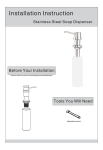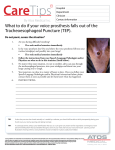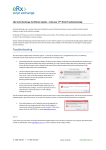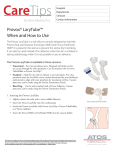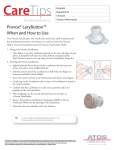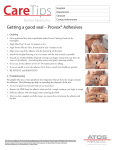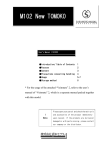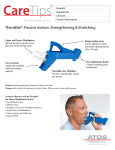Download Artificial Larynx (AL): Basic Training
Transcript
9 Hospital Department Clinician Contact information How to use your AL with neck placement: 1. Familiarize yourself with the AL, read the instructions carefully and practice using the controls; 2. Once your are familiar with the device place the AL on your neck; 3. Firmly but gently push the top of the AL into this area so that the entire top is in contact with your neck; 4. Press the “ON” button when you begin to talk; 5. Mouth the words “hello, how are you?” 6. If you do not understand what you said, move the AL to another soft spot on your neck and try again; and 7. where you can clearly hear yourself the best. Other tips: • Practice with a family member. It is important that everyone gets used to this new way of speaking. Practicing together helps everyone learn and understand this speech better. • Just mouth the words when you begin to speak. • Keep your arm close to your chest when you are speaking, it helps position the head of the AL against your neck. • Keep your chin in its’ normal position when you speak. • Do not force air out of your stoma when trying to speak. • Use natural pauses and sentences. Articulate clearly when you speak. What is an intraoral device and when would you use it? be placed on top of your AL along with an oral straw so that you can use the AL in your mouth. The intraoral (mouth) adapter: When you place the straw into your mouth, do not cover up your mouth. Many listeners read lips to help them understand what you are saying. How do you use an Oral Adapter? 1. 2. Insert the oral straw into the opening at the top of the cap; 3. Place the oral straw in the space between your cheek and teeth; 4. You should place the oral straw on the same side of your mouth as the hand you are using to hold the AL; and 5. Press the ‘ON’ button when you begin to talk. This text does not replace nor does it set forth the complete contents of the User Manual and/or Prescriber Information for the products in this text, and is not a substitute for reviewing and understanding that important information. Therefore, before prescribing and/or using any of the products included in this text, please review the entire contents of the respective User Manual and/or Prescriber Information. For more information contact us at: [email protected] • www.atosmedical.us • 1.800.217.0025 9 Hospital Department Clinician Contact information Artificial Larynx (AL): Basic Training Pitch and loudness: • The pitch of the AL will be set by your speech pathologist during your first treatment session; • Pitch should be adjusted to a level that is appropriate to your age and gender; and • The loudness level should be set so that you can clearly hear yourself within your environment. Articulation (how clear is your voice): You shape sounds into speech using your lips, teeth, roof of your mouth and tongue. 1. Practice mouthing words silently without using the AL; 2. Practice saying /T/; /K/; /P/ & /S/ silently; 3. Mouth the phrase “I’d like a cup of coffee”; 4. Repeat the above with the AL turned on; and 5. Over-exaggerate the movements of your tongue, teeth and lips so that you can be understood better. Timing: • Use the ‘ON/OFF’ button so that sound is only coming out while you are talking and quiet during pauses or in between sentences; • Practice placing the device against your neck or in the mouth (with the intraoral adapter) before pushing the ‘ON/ OFF’ button to start the sound; • Practice the following; Count # 1-20 Days of the week Months of the year • Once you can be easily understood with the words above, start saying longer words, 2-3 word phrases and then sentences while practicing when to turn the AL on or off. Read a few paragraphs of a favorite book out loud to help with timing. Hello, how are you? I’d like a cup of coffee What time is it? My name is... Count to 10 Days of the week (say all days of the week without pausing) Months of the year (pause at April and August) Count from 60-80 (turn on at 60, pause at 65, 70 & 75) * If any problems are noticed that are not listed here, the patient should still take action. This text does not replace nor does it set forth the complete contents of the User Manual and/or Prescriber Information for the products in this text, and is not a substitute for reviewing and understanding that important information. Therefore, before prescribing and/or using any of the products included in this text, please review the entire contents of the respective User Manual and/or Prescriber Information. For more information contact us at: [email protected] • www.atosmedical.us • 1.800.217.0025 MC0824 Practice: © Atos Medical AB, 201208 MC0824-ThUS • You should pause and turn the device off when you would naturally hear pauses in speech. For example, pause after a phrase, when you want to emphasize a word and/or in between sentences. This gives the listener extra time to understand what you have said.


